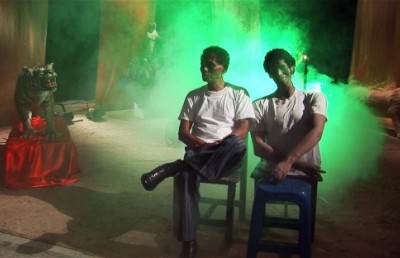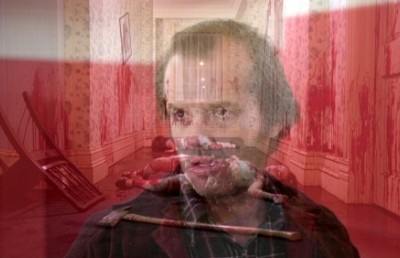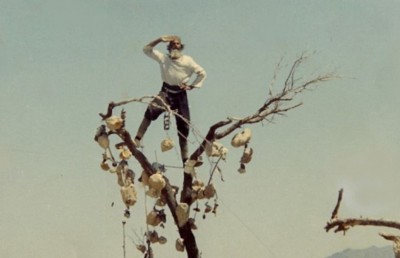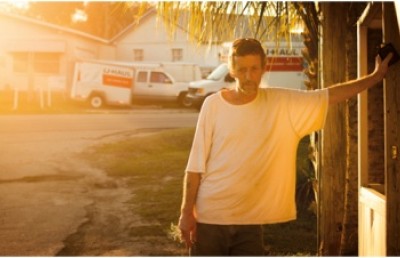Poet of Body and Soul: Walt Whitman, Allen Ginsberg, and the film Kill Your Darlings
What does a film canon respecting mind, spirit, and homoeroticism look like?
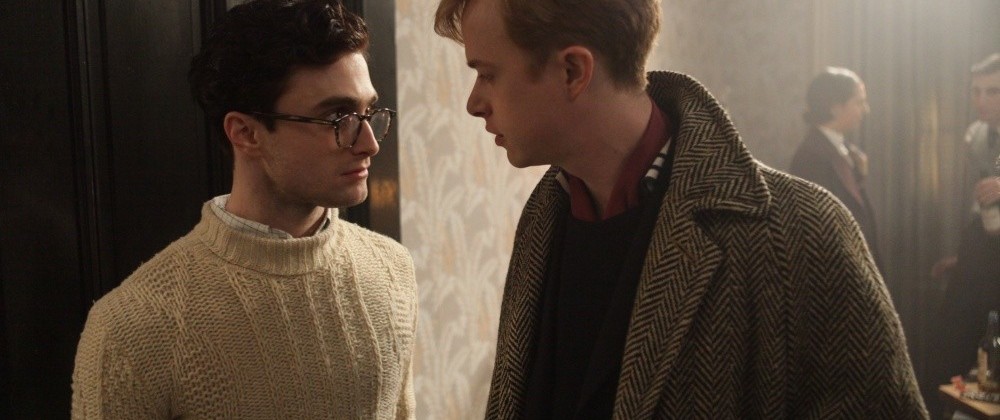
“I am of old and young, of the foolish as much as the wise, / Regardless of others, ever regardful of others, / Maternal as well as paternal, a child as well as a man,” declares the great American poet Walt Whitman in his “Song of Myself,” originally part of Leaves of Grass (Selected Poems, Castle Books, 2000; page 26). Do we dare say as much? What do we share of emotion and thought, dreams and hopes, principles and virtues, beyond the confinements and ignorance of inherited belief and ritual, beyond the pride and privilege of caste and class? What is civilization? Walt Whitman remains remarkable for his determined attempt to affirm the diversity of the human race and the fundamental interconnections of all people. Long Island born, Brooklyn educated, and once an office boy, printer, teacher, and journalist, Walt Whitman was an ordinary man and a great visionary, an elemental and necessary poet of nature, flesh, spirit, pleasure, friendship, love, sex, democracy, and liberty. Walt Whitman’s incantatory rhetoric, with his lines of comparable objects, of perceived and willed bonds, remains a model for other citizens, other dreamers, other writers. Whitman first published Leaves of Grass in 1855, consisting of twelve poems, of ninety-four pages. Emerson and Thoreau were among the few who recognized the significance of Whitman’s freedom of thought and style, although Whitman’s later admirers included writers as diverse as T.S. Eliot and Allen Ginsberg. Whitman would issue ten editions, expanding and revising Leaves of Grass, by the time of his death.
“You would have to give up all else, I alone would expect to be your sole / and exclusive standard,” declared Walt Whitman in his poem “Whoever You are Holding Me Now in Hand,” from the larger “Calamus” series (Selected Poems; page 73). It is an admonition that many writers and revolutionaries and lovers have made—and few received the surrender that Whitman inspired. The sentiment can be perceived in the 2013 film Kill Your Darlings, which depicts the poet Allen Ginsberg, who leaves his family home in New Jersey for the study of literature at Columbia University, where Ginsberg meets the provocative Lucien Carr, a bright dilettante who encourages Ginsberg to attempt something new in life and literature. Directed by John Krokidas, Kill Your Darlings (2013) focuses on the slow, youthful birth of a new creative movement, with young writers moving away from long established texts—texts of enlightenment and eloquence, of measure and meaning, of reason and respectability—to find or create more honest, rude, and vital contemporary work, work that is closer to what people are thinking and feeling in their own day. Rather than conform to old standards, the artists want to create new standards. Lucien Carr (Dane DeHaan), who asserts self-expression, sensual abandon, and amorality, inspires his friends to new personal discoveries and creative work—his friends include Allen Ginsberg (Daniel Radcliffe) and William Burroughs (Ben Foster) and Jack Kerouac (Jack Huston). One of Allen Ginsberg’s professors refers to Ginsberg as Whitman Junior. Daniel Radcliffe as Allen Ginsberg is good, as are most of the other actors—although I am ambivalent about Dane DeHaan as Lucien—he may be too archly self-conscious. Of course, people who want to be and do something different often seem artificial to observers, who are used to the natural appearance of the usual conformity. Kill Your Darlings is just one of several films that tell the story of Allen Ginsberg and his personal and creative associates: Walter Salles’ On the Road (2012), an interpretation of Jack Kerouac’s novel gives the men invented names, but Howl (2010), directed by Rob Epstein and Jeffrey Friedman, attempts a biographical rendering, featuring James Franco as Allen Ginsberg.
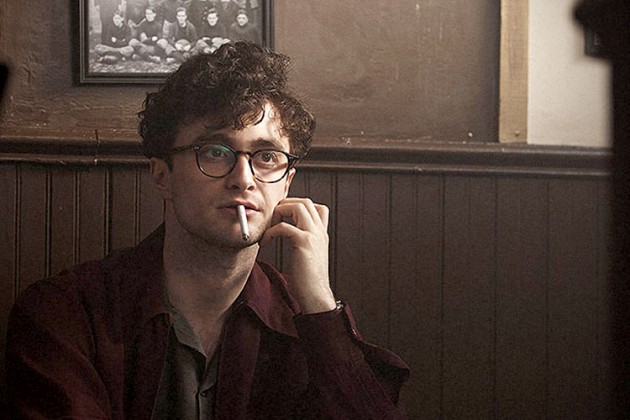
Kill Your Darlings
“I saw the best minds of my generation destroyed by madness, starving hysterical naked, / dragging themselves through the negro streets at dawn looking for an angry fix,” begins Allen Ginsberg’s legendary poem “Howl.” The poem acknowledges triumph and trouble, the contemplation of jazz and literature and lust and madness and poverty, the highs and lows of life and culture, with allusions to dreary apartments and university towers. Ginsberg refers to a “lost battalion of platonic conversationalists” amid flowing lines of appreciation and rage; and Ginsberg mentions those “who let themselves be fucked in the ass by saintly motorcyclists, and screamed with joy.” It is a grand, vulgar poem. Movement and paralysis have their place in the poem. It is a travelogue, but not one found in any brightly colored tourist brochure. It is another New York, another California, another America, bearing witness to “the absolute heart of the poem of life butchered,” a desperate, rebel cry. Was that enough? Is it enough? What are the cultural values and practices that protect and preserve human health, knowledge, prosperity, and safety? What is civilization? The truth is that great art still seems less about the expression of emotion than about its containment and contemplation: the form of the work is container, presentation, the thing that allows distance and perspective for the contemplation of emotion and experience. Allen Ginsberg’s work, through genuine appreciation and his own constant promotion, was taken to speak for a generation.
Allen Ginsberg (1926-1997), of New Jersey and New York (born in Jersey and a mainstay of Manhattan), the author of Howl and Other Poems and Collected Poems 1947-1997, was the son of a poet and teacher, Louis Ginsberg, and a troubled but inspiring mother, Naomi, a Russian immigrant. Ginsberg was a student at Columbia University, and a friend and co-conspirator of William Burroughs and Jack Kerouac. Ginsberg became an experimental artist and a social rebel. Ginsberg, following the advice of poet William Carlos Williams, gave attention to how people spoke, to the breath that animated and punctuated their speech. An individual, especially a writer, is influenced by both solitude and community, and the opportunities for contemplation and communication. For a time Ginsberg lived in San Francisco and became part of the cultural scene there; and his poem “Howl” (1955) was published in 1956 by a San Francisco press, Lawrence Ferlinghetti’s City Lights Books; and the poem was considered obscene by some people, leading to a legal trial. It is important to know the difference between an observation and a critique, or between a critique and an attack—and a crime; and it is important to know the difference between art and pornography. The legal trial of Ginsberg’s poetry engaged the testimony of literary writers and critics, with the judge ruling the poem a significant literary work. “Howl” is an angry, honest, surreal work with roots in Judaism and American literary tradition—Whitman, Melville, an affirmation of the facts and feelings being buried by the polite surface of American culture. Walt Whitman had given his attention to both art and life: Whitman’s attention to his brother George, injured during the American civil war, led to Whitman’s care of other soldiers in 1862; and Whitman wrote tributes to President Lincoln and the men who fought and suffered in battle. Whitman would write “Democratic Vistas” (1871), a critical essay on America. Allen Ginsberg, like Whitman, would be further affected by the life and culture he saw around him, going on to write elegies and celebrations; and Ginsberg became an explorer of spirituality and musical collaboration and drugs, and involved in movements for peace and homosexual rights, as well as an educator of the young.
Allen Ginsberg, like many writers, was something of a paradox, interested in both self-awareness and self-transcendence. I admired Allen Ginsberg when I was a younger man, admired him for his courage and honesty and inclination to experiment, though his work was not as elegant or as logical as I might have wished. I liked poets such as W.H. Auden and Rainer Rilke and Yehuda Amichai, Anna Akhmatova, Gwendolyn Brooks, Constantine Cavafy, Emily Dickinson, Zbigniew Herbert, Langston Hughes, LeRoi Jones, June Jordan, John Koethe, Denise Levertov, Federico Garcia Lorca, Audre Lorde, Robert Lowell, Pier Paolo Pasolini, Octavio Paz, Adrienne Rich, and C.K. Williams. Such cultural refreshment is a delight: deprivation of that joy and wisdom ages the mind, which ages the spirit, which ages the body. Yet, Allen Ginsberg was an icon of creativity and liberty; and I would see Ginsberg walking in the East Village of Manhattan, plump, shambling, attentive to others— but I did not know him. I know some writers found him very particular about the granting of literary favors, but Ginsberg did seem friendly in performance and in person. Allen Ginsberg was a cultural shaman, a rebel as relic, and an image of an old dirty grandfather (I cannot forget the poem in which Ginsberg describes the pleasure of a man who fucked Ginsberg and said he liked getting excrement on his cock—possibly a poet can be too confessional). The film Kill Your Darlings recounts an early episode in the literary life of Allen Ginsberg, when Ginsberg begins to attend Columbia University and meets Lucien Carr. It is an engaging, startling film, although it, reportedly, does not stay close to all the facts (apparently, Ginsberg and Carr did not steal library books, and Ginsberg did not masturbate while writing poetry, although this last assertion, now, may be forever in doubt).
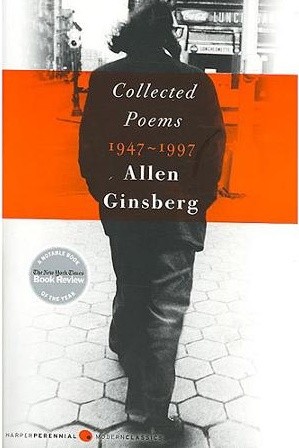
In Kill Your Darlings, Allen Ginsberg at Columbia finds formal manners that do not quite hide the casual class or ethnic prejudices (one young man congratulates himself for being able to identify a Jew), but Ginsberg discovers amusement and fellowship when he meets someone who, like himself, is looking for a wilder form of literature, Lucien Carr. They go to parties, visit jazz clubs, and talk poetry. What is to be done with words? It is idealistic talk that is shadowed by familial and sexual conflicts: Lucien is involved with an older man, David Kammerer (Michael C. Hall), who had met Lucien when Lucien was very young, a boy scout (and Kammerer a troop leader), and whom writes Lucien’s papers for college, and is very possessive. Lucien is willful but weak, a dangerous combination—but Lucien has the admiration of Ginsberg as well as Kammerer and William Burroughs and Jack Kerouac. “The story, largely told through the romantic imagination of the young Allen Ginsberg (Daniel Radcliffe), is styled as something of a 1940s film noir sieved through a 1960s Claude Chabrol New Wave murder mystery, with occasional hits of contemporary pop (TV on the Radio) mixed with bebop, blues, and the Andrews Sisters. This is Krokidas’s first feature, and it’s astonishing that he, with the aid of cowriter Austin Bunn and cinematographer Reed Morano, pulls off a seamless fusion of periods while smoothly uniting his own POV with that of his protagonist, all without ever suggesting anything as banal as universality,” observed Amy Taubin of the online Artforum (October 21, 2013). Kill Your Darlings is “too excitable to be reliable, but it captures something of the period’s manic self-abasement,” observed Andrew O’Hagan, when considering Burroughs, Ginsberg, and Carr in the New York Review of Books (October 9, 2014). The scenario—experimental artists, bohemian men, beginning to explore art and homosexuality—may not be the kind of film that everyone can expect to relate to, yet in the search for beauty and fellowship one sees an elemental humanity.
It is important to recognize the true contours of the time in which one lives—the culture, economy, politics, and spiritual temperament—but it is just as important to try to see beyond them, to imagine a more creative, humane, intelligent, and joyful future. The experiments of the young men in the film On the Road offer sensation and pleasure, distraction, rather than purpose or wisdom; and as time passes, it becomes clear that pleasure is not enough. Work, that old familiar requirement, becomes fulfillment, justification. In On the Road, Garrett Hedlund as Dean Moriarty is the freest spirit and the least accomplished, with the other men all writers—Sam Riley is Sal, Tom Sturridge is Carlo, and Viggo Mortensen is Old Bull Lee (the characters Sal, Carlo, and Lee are doubles for Kerouac, Allen Ginsberg, and William Burroughs, with Dean one view of Neal Cassady). “The literary and larger cultural argument that Kerouac’s book ignited and engaged—about formalism, narrative, morality and breaking open new ways of being and expression—is virtually nonexistent in On the Road, Walter Salles’ warm but strangely staid adaptation of a piece of literature that was never meant to be tamed as cinema,” declared film critic Ann Hornaday in The Washington Post (March 22, 2013).
It can be difficult to know what is of lasting value in changing times, the traditional or the new, the intellectual or the sensual, the moral conscience or strange, thrilling liberties. One can wager wrong and lose all. The New York Times film critic A.O. Scott, notes how literary works became tamed by academic acceptance, but finds that the Epstein/Friedman film Howl returns us to a time when Allen Ginsberg’s work was new and arresting (thought obscene, it inspired a legal trial), with the film Howl finding ways of bringing freshness to what is now history, with a complex and appealing performance—bold, diffident, oracular, playful—by James Franco as Ginsberg. “What the audience sees, meanwhile, is a courtroom drama (though farce might be a better word), with Jon Hamm and David Strathairn arguing the case in front of Bob Balaban; a coffeehouse reading and a long tape-recorder session with James Franco embodying Ginsberg; black-and-white montages depicting Ginsberg’s earlier life, in particular his sexually charged friendships with Jack Kerouac (Todd Rotondi) and Neal Cassady (Jon Prescott) and his blissful union with Peter Orlovsky (Aaron Tveit); and animated sequences evoking passages from ‘Howl’,” wrote A. O. Scott (New York Times, September 23, 2010). The film presents Franco as Ginsberg in an interview, an interview in which the magazine Variety’s film critic Todd McCarthy observes “Ginsberg admits, among many other things, to his fear of his teacher-poet father’s reaction to his work; his mother’s madness; his sexual infatuations; his psychiatry-inspired breakthrough to live a fully honest, unconstrained life; and his view that Howl was not, as some perceived, a promotion of the merits of homosexuality but at its heart an argument for ‘frankness about any subject.’ It’s in these thoughtful, off-the-cuff interludes that Franco can come closest to fully inhabiting Ginsberg, which he does with great credibility; despite doubts going in about how plausible the handsome actor would be as the poet much more familiar from his later life as looking plump, balding and unkempt, it’s a good fit in the end, physically and vocally” (January 21, 2010). However, Todd McCarthy finds the well-received film to have a fundamentally academic attraction, and to be too dry.
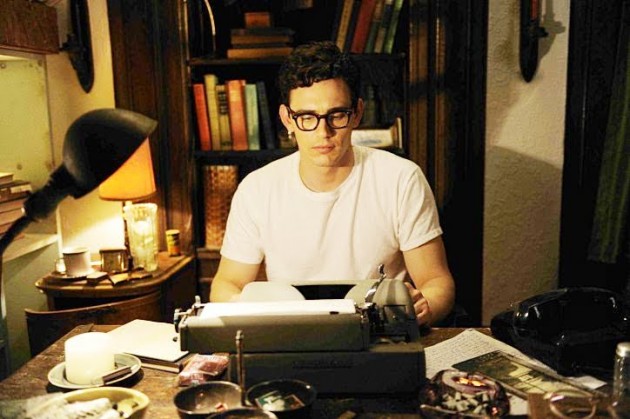
James Franco as Ginsberg
II.
The twentieth century was an age of world wars, national revolutions, the atom bomb, airplanes, landing on the moon, electricity, computers, literary modernism, cinema, jazz, rock-and-roll, and sexual candor. It was an age that saw more complicated ways of looking at gender and sexuality. In Kill Your Darlings, a college students warns Allen Ginsberg away from Manhattan’s Greenwich Village, calling it the land of fairies, from which no one who goes there returns. It is amusing, though a declaration of bigotry. The 1940s were part of an age when much of sexuality was secret or scandal, and there was less talk of sexual orientation or preference than of perversity: preference suggests conscious choice, whereas orientation suggests irrational fixation, neurotic impulse, or, simply, what lacks consciousness or will, what some people like to think of as nature; but human life is about the transformation of nature. That is what civilization is usually defined as: the move away from nature into an evolved condition. Allen Ginsberg does go to Greenwich Village with Lucien Carr, and, arguably, does not return to the thinking of establishment culture. It is his encounter with strangeness, and a step into the future, where Ginsberg meets William Burroughs inhaling gas while lying in a bathtub. Evolution occurs differently in each life.
For some people evolution might have begun with literature, with Andre Gide, D.H. Lawrence, Evelyn Waugh, Gore Vidal, Yukio Mishima, James Baldwin, and Christopher Isherwood. Or the more scandalous work of Jean Genet and William Burroughs. Andre Gide in The Immoralist (1902) wrote about vital individuality and the constraints of society, faith and agnosticism, marriage and male friendship and the pursuit of a boy, focusing on a young man and his questionable marriage to a religious young woman, and his flight to another land and subsequent erotic obsession. D. H. Lawrence’s Women in Love, about two friends and their relationships with a couple of sisters, presents a very close male friendship, suggesting a realm of eroticism as well as emotion in the male bond, was published in 1920. Jean Genet in Our Lady of the Flowers (1943) depicted a culture of disguise, exploitation, fantasy, sex, and twisted values, of ritualized death. Evelyn Waugh’s Brideshead Revisited (1945) focused on the romantic friendship of painter Charles and aristocrat Sebastian, with the spiritual and sexual torment of Sebastian, a Catholic, making him the book’s central tragic figure. Gore Vidal wrote The City and the Pillar in 1946, and it was published two years later in 1948, a book in which one young man is haunted by his youthful sexual encounter with another young man. Yukio Mishima published fiction about conformity and hidden homosexuality in Confessions of a Mask (1949), and Forbidden Colors (1951), the latter giving thought to aesthetics and virtue, principle and hypocrisy, homosexuality and misogyny. James Baldwin’s Giovanni’s Room, on the betrayal of love between two men, an American and an Italian in France, was published in 1956; and his Another Country (1962) featured men who had passionate—desirous, revelatory, troubling—relationships with women and other men. William Burroughs’ The Naked Lunch (1959), a work of bizarre hallucinatory fragments, of drugs, nightmare, sinister wit, and perversion, inspired consideration of law and transgression, including the questionable centrality of addiction and sexual exploration (pedophilia). Christopher Isherwood published A Single Man, about the grief of one man for another, in 1964.
There would be other books of various kinds: James Purdy’s Eustace Chisholm and the Works (1967), Gordon Merrick’s The Lord Won’t Mind (1970) and An Idol for Others (1977), Edmund White’s A Boy’s Own Story (1982), John Robert Baker’s Tim and Pete (1993), and John A. Williams’s Clifford’s Blues (1999); and The Sexual Outlaw (1977) by John Rechy; Christianity, Social Tolerance, and Homosexuality (1980) by John Boswell, Homosexuality: Power and Politics (1980) by Gay Left Collective, The Celluloid Closet (1981) by Vito Russo, The Homosexualization of America (1983) by Dennis Altman, and more, and much later, Vice Versa: Bisexuality and the Eroticizing of Everyday Life (1996) by Marjorie Garber, and Homosexuality and Civilization (2003) by Louis Crompton. The literary events corresponded to some social movement: The Society for Human Rights was founded in Chicago by Henry Gerber in 1924, publishing Friendship and Freedom, a resource for homosexuals; and the lesbian group Daughters of Bilitis was founded in 1955; and in 1961 Illinois was the first American state to decriminalize homosexuality (European countries were becoming more liberal too); and the Mattachine Society—founded in 1950 by Harry Hay—protested the prohibition against serving alcohol to known homosexuals by sitting in at Julius’s Bar in Manhattan in 1966. The Stonewall Riots, following a police raid, were in 1969. Doctor Fritz Klein founded The Bisexual Forum in 1974. Homosexuality, as a mental disorder (listed in 1952), was removed from the Diagnostical and Statistical Manual, an important medical text, in 1974, following a 1973 trustee vote of the American Psychiatric Association. Harvey Milk was elected in San Francisco in 1977, and some twenty years or so later, in 1999, same-sex couples were allowed to marry in Vermont; and, in the United States, the Supreme Court decriminalized homosexuality in 2003.
It is hard to remember, and possibly harder to think about, some of the early films that attempt to present homosexuality as a theme: After 1895’s Dickson Experimental Sound Film by William Kennedy Dickson, and Charlie Chaplin’s A Woman (1915) and Alfred Hitchcock’s Rope (1948), there was Tea and Sympathy (1956), and Cat on a Hot Tin Roof (1958) The Children’s Hour (1961), Reflections in a Golden Eye (1967), and The Killing of Sister George (1968). In Tea and Sympathy, directed by Vincente Minnelli, a prep school boy is thought too sensitive, even feminine, by his classmates, and is taunted, a story that suggests a troubling possibility for the culture of the time—which was more directly explored in the original stage play by Robert Anderson. In Richard Brooks’ film interpretation of Tennessee Williams’ play Cat on a Hot Tin Roof, Brick (Paul Newman) drinks as he grieves his dead friend Skipper, ignoring his attractive wife (Elizabeth Taylor); and in William Wyler’s The Children’s Hour, a girl makes a false claim that two female teachers are having a lesbian affair and they sue for libel; and Marlon Brando is Major Penderton, married to a woman, Leonora (Elizabeth Taylor), but infatuated with a young solider, Private Williams (Robert Forster), in John Huston’s Reflections in a Golden Eye; and in Robert Aldrich’s The Killing of Sister George a tough alcoholic lesbian plays a sweet nun on a soap opera until there are plans to get rid of her character.
Since then, there have been other films—American films, international films—that have chosen the discovery and exploration of sexuality as a theme. It has become an important subject. Among the films that are significant for their characters, stories, and aesthetic appeal, and respectable treatment of relationships between men are Death in Venice, and It’s Not the Homosexual Who Is Perverse, But the Society in which He Lives, and Fox and His Friends, My Beautiful Laundrette, Looking for Langston, Edward II, Wild Reeds, Total Eclipse, Happy Together, and Kinsey.
Death in Venice (1971) is a film adaptation of Thomas Mann’s 1912 novella about a writer’s infatuation, directed by Luchino Visconti as the story of a composer, focusing on an aesthete’s fascination with a beautiful boy, with Dirk Bogarde as the aging Aschenbach and Bjorn Andresen as the young Tadzio, inspiring questions about beauty and morality and purpose. Surprising feelings bubble up through formal structure and routine, making the aesthete realize that genuine events are frequently not planned—and yet the strange can have a classical resonance. Love moves the mind toward wisdom; and yet the great man is made to appear foolish as he seeks to draw attention to his own presence, during a time of plague. The exacting film critic Pauline Kael found the film itself beautiful, but full of false climaxes, with less impact than expected. Yet, who but Visconti, the director of Rocco and His Brothers (1960) and The Leopard (1963), might have attempted the film?
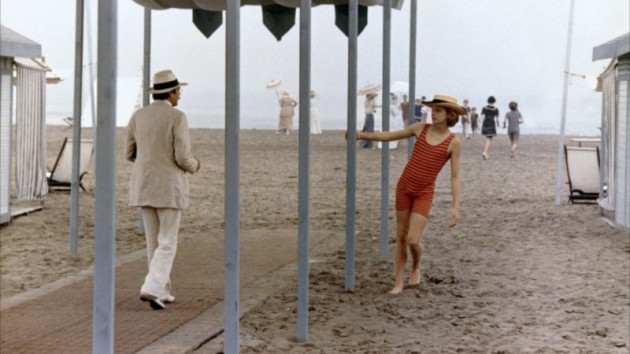
Death in Venice
It’s Not the Homosexual Who Is Perverse, But the Society in which He Lives (1971), directed by Rosa von Praunheim, is a work focused on a provincial young man who leaves the country and arrives in the city, Berlin, drawn to a dynamic but artificial life, full of shallow appearances and superficial pleasures. It is a portrait of misplaced hopes, of decadence. Holger Mischwitzky, better known Rosa von Praunheim, was born in a prison and later adopted; a painter and writer and political activist as well as a filmmaker, he has made more than seventy films. Commenting on a retrospective on von Praunheim’s work, film critic Melissa Anderson wrote, “Two years after the Stonewall riots, von Praunheim nearly ignited another queer intifada with his first feature, It Is Not the Homosexual Who Is Perverse But the Society in Which He Lives (1971). A Brechtian soap opera with endlessly quotable narration, It Is Not savages gay-male self-destruction and the pathological need to fit into bourgeois culture: ‘Faggots don’t want to be faggots. They don’t want to be different. They live in a dream world of glossy magazines and Hollywood movies,’ intones the first of several increasingly hysterical, thickly Teutonic voices, before this utopian call-to-arms is sounded: ‘Let’s work together with the blacks and women’s liberation. Get involved politically. Being gay is not a career.” (The Village Voice, June 3, 2009). The admonition to build such a coalition remains to be answered; and yet there has been progress.
Fox and His Friends (1975), directed by Rainer Werner Fassbinder, presents a working class man who is exploited by the haute-bourgeoisie for his new fortune, an indictment of cults of class and sexuality. Andrew Sarris, commenting on Fox and His Friends, Beware of a Holy Whore, and other Fassbinder works, considered Fassbinder an original, with a bleak vision, though influenced by Douglas Sirk and Sam Fuller, someone who saw the world as a struggle for power with vital victims, an artist with a transcendent though unique vision (The Village Voice, November 22, 1976).
My Beautiful Laundrette (1986), directed by Stephen Frears, with a screenplay by Hanif Kureishi, is one of the most charming films of the 1980s. Focused on ambitious Pakistanis in Britain, a family that still feels its own difference yet is making a place for itself in the economy and society, the film’s center is Omar (Gordon Warnecke) and his proletarian friend Johnny (Daniel Day-Lewis), who work and play together, and their play includes kisses.
Looking for Langston (1988), directed by Isaac Julien, considers the death of the poet Langston Hughes, and speculates about his biography and sexual identity. Langston Hughes—a mid-western American, the son of a school teacher mother, a boy poet, a ship’s crewman, and historian’s assistant, and a Lincoln University college graduate—wrote poetry, short stories, and plays. In the Langston Hughes poem “Café: 3 a.m.” (The Collected Works of Langton Hughes, The Poems, 1951-1967, Univ. of Missouri Press, 2001; page 48), Langston Hughes comments on a police raid of a gay bar, noting “But God, Nature, / or somebody / made them that way.” Is a woman nearby a police woman, or a lesbian, or both? It was this kind of poem that inspired speculation about the sympathy of Hughes for homosexuals, and aroused interest in his mysterious sexual life. Was Langston Hughes asexual, bisexual, homosexual, or heterosexual? There have been conflicting claims about his orientation, preferences, and experiences. Who can bear the burden of being other in multiple categories? Yet, bear that burden seems to be what scholar Alain Locke, sculptor Richmond Barthe, and poet Countee Cullen did; and what intellectuals and artists Bayard Rustin, James Baldwin, Alvin Ailey, Little Richard, Andy Bey, and Samuel Delany did; and what artists and writers Glenn Ligon, Randall Kenan, John Keene, and Kehinde Wiley are doing. Isaac Julien’s film Looking for Langston, released in England in 1988 and in America a year later, is less about the fact of one man’s sexuality than the claims made upon the man and his work. How can his work be seen and used? The scholar Henry Louis Gates Jr saw in Looking for Langston, with its inclusion of writing by Langston Hughes, Richard Bruce Nugent, James Baldwin, and Essex Hemphill, and the voice of Stuart Hall, as a simultaneous meditation on 1920s Harlem and 1980s black Britain. “The result is an interlacement of past and present, the blues, jazz, Motown, and contemporary dance music, London and New York: a trans-temporal dialogue on the nature of identity and desire and history” (Tradition and the Black Atlantic, Basic Civitas Books/Perseus, 2010; page 56). Gates found that the Harlem Renaissance was “surely as gay as it was black, not that it was exclusively either of those things” (57).
Edward II (1991), directed by Derek Jarman, an avant-garde work written by Jarman and Ken Butler, is loosely based on Marlowe’s great play, in which King Edward II’s favorite is returned from exile, despite the disapproval of his closest noble allies; and upon his return, Edward II gives his favorite, Piers Gaveston, titles and properties, and condemns a bishop to die. The play is not simply about love versus duty: it examines the accusation that homosexuality is disloyal to established culture. In the Derek Jarman film, King Edward II (Steven Waddington) abandons his wife Isabella (Tilda Swinton) for a male lover, Piers Gaveston (Andrew Tiernan); and Edward II neglects his duties, as well as his wife, which makes and emboldens enemies; but director Jarman attempts to reverse the brutal fate of the king.
Wild Reeds (1994), directed by Andre Techine, is a work focusing on early 1960s youth, in which two young men and a young woman have friendship and the possibility of love: Francois (Gael Morel), who is liked by Maite (Elodie Bouchez), falls for Serge (Stephane Rideau), who likes Maite. Wild Reeds is one of the films that assumes a lightness in its interpretation of sexuality, a sense of joy and possibility. Other significant films on gender, sexuality, and social impact, include: Before Night Falls, Brokeback Mountain, Far from Heaven, The Kids Are All Right, Law of Desire, Lianna, Longtime Companion, Parting Glances, The Perks of Being a Wallflower, Pariah, Personal Best, Philadelphia, Saving Face, Time Regained, and The Watermelon Woman.
Total Eclipse (1995), directed by Agnieszka Holland, takes as its subject the literary and personal relationship between the French symbolist poet Paul Verlaine (David Thewlis) and the libertine surrealist Arthur Rimbaud (Leonardo DiCaprio), who seduced the married Verlaine with his poetry, idiosyncratic manners, and youthful body, leading to conflict and condemnation before the law. The film captures the passion and conflict between the poets, rather than presenting a rosy picture. It is shocking and funny and difficult to forget.
Happy Together (1997), a film by Wong Kar Wai, looking at the desire, love, pain, and separation in the affair of two young men, is beautiful, fragmented, sensuous, and sad—it is strange to feel good at the sight of heartbreak, but the vivid truth that is created within the film is exhilarating. Lai Yiu-Fai (Tony Leung Chiu-wai) and Ho Po-Wing (Leslie Cheung Kwok-wing) are the lovers in this, one of the most memorable films: and they move through states of desire and disappointment as they move from Hong Kong to Buenos Aires. “During its making, the movie underwent even more changes than is normal for a Wong pic. The location shoot dragged on for four months, from September to December last year, in difficult working conditions; the original storyline was massively altered during shooting; and characters and subplots were eliminated after the original three-hour cut. Final result (with a reported tab of $4.2 million) is one of Wong’s most straightforward movies in some time, pared back to concentrate on only three characters, and as pure a piece of almost plotless, metaphysical cinema as he’s made in his career,” reported Derek Elley in Variety (May 25, 1997). The film’s production had the improvisational quality of jazz, and like jazz it has its wondrous found moments. The relationship between the two lead characters have the strains and stresses of life—expectation, frustration, resistance, tenderness. When Ho Po-Wing’s dissolute life leads him, after he is attacked, back to Lai Yiu-Fai for care, they squabble—and it is funny and humiliating for both. “Even then, Ho behaves like a spoiled, dictatorial brat, demanding that his lover, stricken with the flu, leave his sick bed to cook for him. Looking back later, Lai moons about how the period of Ho’s recovery was one of the couple’s happiest,” remarked the New York Times writer Stephen Holden (October 10, 1997).
Kinsey (2004), directed by Bill Condon, is about the studies of Alfred Kinsey (Liam Neeson) into human sexuality, which includes as well Kinsey’s erotic experience during a trip with his research assistant Clyde Martin, (played by Peter Sarsgaard). Alfred Kinsey, the author of Sexual Behavior in the Human Male (1948), found that sexuality had its ambiguities and complexities, and that few were entirely heterosexual or homosexuality—and that bisexuality is a fact (men who did not identify as homosexual had homosexual experiences). The film Kinsey is one of an increasing number of films that take the discovery and exploration of sexuality as a subject, a controversial topic in American life. There are film genres in which American identity, community, purpose, and values are worked out—war movies and westerns, legal case procedurals, public and private school stories, sports films, labor union and political campaign dramas, and biographies. Biographies may be the most difficult of them all—the largest philosophical and social significance can be lost in the attention to emotion, personal relationships, and private details. Sight is often lost of the discipline and impersonal mission that inspired a great career.
III.
How much of human knowledge does one allow into one’s life and work? How much of the world? The emphatic embrace of human existence in the work of Walt Whitman and Allen Ginsberg remains a great challenge. One of the strengths of the film Kill Your Darlings is its busyness, its animated, pictured partitions of Ginsberg’s life: his family; his college studies, and his bohemian friends. The characters and the events of each community have their own drives and rituals—exhaustion and pain; formalism and its subversion; pleasure and excess. Flight appeals to several of the characters in Kill Your Darlings but it is hard to escape the self. Reconciliation or resolution is a more sensible goal. Ginsberg brought lived experience to his work, in all its messiness. The power of Allen Ginsberg’s poetry was rooted in his speaking the forbidden, but what happens when what was forbidden becomes acceptable? The shock is gone—and one is forced to ask, Is there beauty or craft or logic or wisdom present? Some of Ginsberg’s work can seem mere diary jottings or propaganda for a minority sensibility. It may be too soon to know whether he was merely a poet of his time, or, like Whitman, a poet for all time.
Walt Whitman contained multitudes, was transcendent. He spoke of and for the young and the old, the rich and the poor—and of and for women as well as men. In Walt Whitman’s poem “A Woman Waits For Me,” Whitman affirms the complex and complete appeal of women as well as men, the sensual and the spiritual appeal, expressing desire and satisfaction with women, an impressive and precise eroticism, suggesting a radical ambisexuality, seeing in sex the rejuvenation of the world (Selected Poems; page 85). Walt Whitman writes of the casual but thrilling love of a woman in “Once I Pass’d Through a Populous City,” and it is an intense, easily convincing reverie (Selected Poems; page 95). One has to repress willfully this testimony in order to pay sole attention to the homoerotic in Walt Whitman’s work. (I always find people who articulate rigid heterosexuality or homosexuality to be boring, dreary—lacking imagination and intellect.) Whitman’s imagination and compassion extended to others: “I am the hounded slave, I wince at the bite of the dogs,” Whitman claimed in “Song of Myself” (Selected Poems; page 30); and in another poem, “At Auction” he again wrote about slavery and affirmed the enslaved. (He did not embrace the diminishment of the enslaved as a justification for slavery.) Whitman’s eyes glanced at all; and his spirit followed.
In the film Kill Your Darlings, Allen Ginsberg tries to be a bridge between his disturbed mother and impatient father—and he, like Walt Whitman, would be, later, a bridge between cultures, between divergent perspectives and experiences. Kill Your Darlings suggests the search for the beloved community: after the wreckage of family, there is the promise of creative friends. Yet there are rivalries for attention among the men. Their fellowship is driven and limited by the hope that one will strike a deeper intimacy than another—that Lucian will like Allen more than David. The rivalries—the selfishness and the spite—are the exact opposite of what one hopes for in a beloved community. Thus one can suspect an end at the beginning, bitterness beneath the sweet. Lucien embodies an ideal and speaks of ideals, promising transformation: he is a broken angel. Broken or wounded men, Lucien’s friends, do not see how broken Lucien is; and that romantic blindness is dangerous. Self-perception must take in more than one’s own good intentions—it must take in one’s actions, both the accomplishments and the mistakes. In the film, Ginsberg becomes aware of his erotic desire for Lucien Carr, seeks him and cannot find him; and then Ginsberg goes to bed with someone who bears a resemblance to Lucien: an illustration of desire moving from the particular to the general, with desire for one man becoming desire for other men. Lucien Carr commits a fatal crime in Kill Your Darlings —as he did in life: Lucien killed David Kammerer, claiming his violence was part of repelling homosexual advances that were not wanted. (It has been reported that in death David Kammerer’s cock was hard still, after being dragged out of the river in which Carr threw him: was that arousal or rigor mortis?) It is difficult to believe such a defense—an honor killing—was acceptable or persuasive, but it was accepted and Carr spent only two years in jail. Ginsberg is depicted as torn about how to respond to this brutal act, this strange assertion. The repudiation of moral conscience can lead to murder; and the failure to condemn moral offense leads to compromise of principle. It is not enough to resist the established life or culture, with its conventions of thought, manners, and habits: one has to replace that establishment with something at least equally significant. American culture has grown more coarse, more casually vulgar and violent, since the publication of Allen Ginsberg’s Howl.
What is civilization? What do we want to bequeath to future generations? What are the institutions and traditions of the past or present that embody the best of what we know? Classical education and popular culture, as well as progressive political tradition, are more important for the ignorant and the poor than for anyone else (not that the poor are always ignorant, or the ignorant always poor): organized culture and tradition are resources of fact, idea, and significant information that may not exist otherwise in one’s daily life. Organized culture and tradition are necessary references and resources—if one wants to know more; if one wants to change one’s life; if one seeks transcendence. Innovations must be critiqued, tested. Many people resent knowledge and moral principle, too many, and want only the liberty to indulge their impulses and instincts, no matter how ignorant or idiotic those impulses are, nor how cruelly they may injure others. Allen Ginsberg’s loyalty to his friend Lucien was respectable, but his failure to condemn murder is an extreme form of negative freedom, of immorality. One remembers that near the end of “Song of Myself,” published in Selected Poems by Castle Books of New Jersey (page 36), Walt Whitman (famously) said, “Do I contradict myself? / Very well then I contradict myself. / (I am large. I contain multitudes.)”
(Article submitted December 2014)


